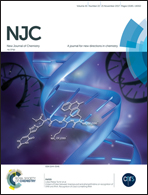Theoretical guidance for experimental research of the dicyandiamide and methacrylic acid molecular imprinted polymer
Abstract
In this study, molecular imprinted polymers (MIPs) have been prepared using dicyandiamide (DCD) as the template molecule, methacrylic acid (MAA) as the functional monomer, and pentaerythritol triacrylate (PETA) as the cross-linker. On the basis of density functional theory (DFT), we simulated the pre-configuration between DCD and MAA by Gaussian 09 software. The best imprinted molar ratio was optimized according to the geometric configuration of the stable complexes, the bonding situation, and the binding energy (ΔE). The nature of the imprinting effect was also studied by topological analysis. The theoretical results indicated that the optimum molar ratio was 1 : 5. The ultraviolet spectra showed that the complex with the molar ratio 1 : 5 showed the largest absorbance at λ = 216 nm. The apparent maximum adsorption quantity (Qmax) was 17.24 mg g−1. In this study, the DCD-MIPs displayed good adsorption properties towards DCD, which could be applied for the separation and detection of DCD in a complex matrix.



 Please wait while we load your content...
Please wait while we load your content...